Related Research Articles

Michelangelo di Lodovico Buonarroti Simoni, known mononymously as Michelangelo, was an Italian sculptor, painter, architect, and poet of the High Renaissance. Born in the Republic of Florence, his work was inspired by models from classical antiquity and had a lasting influence on Western art. Michelangelo's creative abilities and mastery in a range of artistic arenas define him as an archetypal Renaissance man, along with his rival and elder contemporary, Leonardo da Vinci. Given the sheer volume of surviving correspondence, sketches, and reminiscences, Michelangelo is one of the best-documented artists of the 16th century. He was lauded by contemporary biographers as the most accomplished artist of his era.
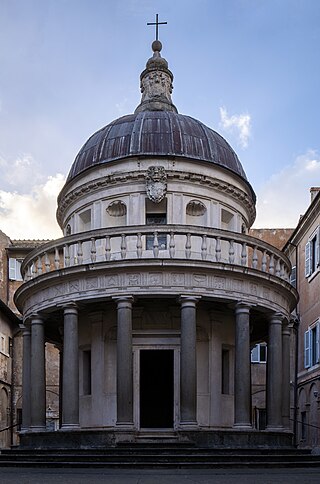
Renaissance architecture is the European architecture of the period between the early 15th and early 16th centuries in different regions, demonstrating a conscious revival and development of certain elements of ancient Greek and Roman thought and material culture. Stylistically, Renaissance architecture followed Gothic architecture and was succeeded by Baroque architecture and neoclassical architecture. Developed first in Florence, with Filippo Brunelleschi as one of its innovators, the Renaissance style quickly spread to other Italian cities. The style was carried to other parts of Europe at different dates and with varying degrees of impact.

Donato di Niccolò di Betto Bardi, known mononymously as Donatello, was an Italian sculptor of the Renaissance period. Born in Florence, he studied classical sculpture and used his knowledge to develop an Early Renaissance style of sculpture. He spent time in other cities, where he worked on commissions and taught others; his periods in Rome, Padua, and Siena introduced to other parts of Italy the techniques he had developed in the course of a long and productive career. His David was the first freestanding nude male sculpture since antiquity; like much of his work it was commissioned by the Medici family.

Filippo di ser Brunellesco di Lippo Lapi, commonly known as Filippo Brunelleschi and also nicknamed Pippo by Leon Battista Alberti, was an Italian architect, designer, goldsmith and sculptor. He is considered to be a founding father of Renaissance architecture. He is recognized as the first modern engineer, planner, and sole construction supervisor. In 1421, Brunelleschi became the first person to receive a patent in the Western world. He is most famous for designing the dome of the Florence Cathedral, and for the mathematical technique of linear perspective in art which governed pictorial depictions of space until the late 19th century and influenced the rise of modern science. His accomplishments also include other architectural works, sculpture, mathematics, engineering, and ship design. Most surviving works can be found in Florence.

Florence Cathedral, formally the Cathedral of Saint Mary of the Flower, is the cathedral of Florence, Italy. It was begun in 1296 in the Gothic style to a design of Arnolfo di Cambio and was structurally completed by 1436, with the dome engineered by Filippo Brunelleschi. The exterior of the basilica is faced with polychrome marble panels in various shades of green and pink, bordered by white, and has an elaborate 19th-century Gothic Revival façade by Emilio De Fabris.
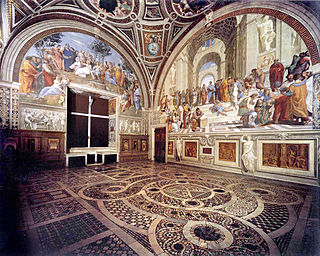
In art history, the High Renaissance was a short period of the most exceptional artistic production in the Italian states, particularly Rome, capital of the Papal States, and in Florence, during the Italian Renaissance. Most art historians state that the High Renaissance started between 1490 and 1500, and ended in 1520 with the death of Raphael, although some say the High Renaissance ended about 1525, or in 1527 with the Sack of Rome by the mutinous army of Charles V, Holy Roman Emperor, or about 1530. The best-known exponents of painting, sculpture and architecture of the High Renaissance include Leonardo da Vinci, Michelangelo, Raphael, and Bramante. In the 21st century, the use of the term has been frequently criticized by some academic art historians for oversimplifying artistic developments, ignoring historical context, and focusing only on a few iconic works.
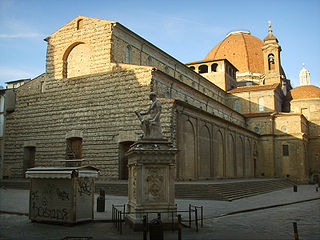
The Basilica di San Lorenzo is one of the largest churches of Florence, Italy, situated at the centre of the main market district of the city, and it is the burial place of all the principal members of the Medici family from Cosimo il Vecchio to Cosimo III. It is one of several churches that claim to be the oldest in Florence, having been consecrated in 393 AD, at which time it stood outside the city walls. For three hundred years it was the city's cathedral, before the official seat of the bishop was transferred to Santa Reparata.
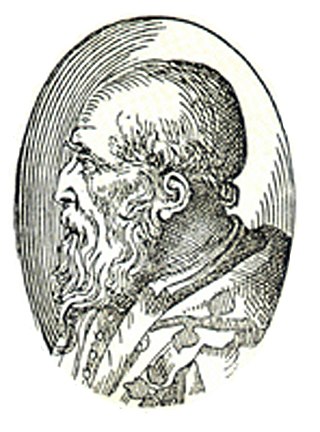
Michele Sanmicheli, sometimes also transcribed as Sammicheli, Sanmichele or Sammichele, was an Italian architect and urban planner who was a citizen of the Republic of Venice.

A baluster is an upright support, often a vertical moulded shaft, square, or lathe-turned form found in stairways, parapets, and other architectural features. In furniture construction it is known as a spindle. Common materials used in its construction are wood, stone, and less frequently metal and ceramic. A group of balusters supporting a handrail, coping, or ornamental detail is known as a balustrade.

Florentine painting or the Florentine School refers to artists in, from, or influenced by the naturalistic style developed in Florence in the 14th century, largely through the efforts of Giotto di Bondone, and in the 15th century the leading school of Western painting. Some of the best known painters of the earlier Florentine School are Fra Angelico, Botticelli, Filippo Lippi, the Ghirlandaio family, Masolino, and Masaccio.

A modello, from Italian, is a preparatory study or model, usually at a smaller scale, for a work of art or architecture, especially one produced for the approval of the commissioning patron. The term gained currency in art circles in Tuscany in the fourteenth century. Modern definitions in reference works vary somewhat. Alternative and overlapping terms are "oil sketch" (schizzo) and "cartoon" for paintings, tapestry, or stained glass, maquette, plastico or bozzetto for sculpture or architecture, or architectural model.

De pictura is a treatise or commentarii written by the Italian humanist and artist Leon Battista Alberti. The first version, composed in Latin in 1435, was not published until 1450. It is one of his three treatises on art; the other two are De statua and De re aedificatoria, that would form the Renaissance concept for the fine arts: painting, sculpture, and architecture.
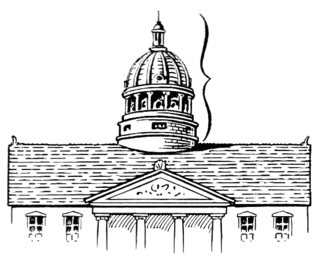
Italian Renaissance domes were designed during the Renaissance period of the fifteenth and sixteenth centuries in Italy. Beginning in Florence, the style spread to Rome and Venice and made the combination of dome, drum, and barrel vaults standard structural forms.
Paul Davies is professor of the history of art at the University of Reading. Davies is a specialist in the architecture of Italy 1350–1650, centrally planned churches and the architectural response to miracles, architecture in Venice and the Veneto, and Italian Renaissance architectural drawings.
Deborah Janet Howard, is a British art historian and academic. Her principal research interests are the art and architecture of Venice and the Veneto; the relationship between Italy and the Eastern Mediterranean, and music and architecture in the Renaissance. She is Professor Emerita of Architectural History in the Faculty of Architecture and History of Art, University of Cambridge and a Fellow of St John's College, Cambridge.
Marjorie Elizabeth Cropper is a British-born art historian with a special interest in Italian and French Renaissance and Baroque art and art literature. Dean of the National Gallery of Art’s Center for Advanced Study in the Visual Arts (CASVA) since December 2000, she previously held positions as Professor of Art History at Johns Hopkins University and director of the university’s Charles S. Singleton Center for Italian Studies at Villa Spelman in Florence.
Helen Hills is a British art historian and academic. She was appointed Anniversary Reader of Art History at the University of York in 2005 and promoted to Professor of History of Art in 2008. Hence she was the first woman professor of Art History at that University Before this Helen Hills taught at the Universities of Keele and Manchester in the UK, at Queen's University in Canada and at the University of North Carolina at Chapel Hill. She has published numerous books and articles on art and architectural history. She has particular research interests in the baroque, and was a guest contributor to the BBC radio programme In Our Time about The Baroque Movement in November 2008 and "Night Waves" on 'The Baroque'.
Andrew Dermot Morrogh is a British art historian and academic. He has taught in the United States at the University of Oregon College of Design and assistant at the Department of Art History at the University of Chicago. He has published several books and articles on the art and architecture of the Italian Renaissance. Among his publications is the catalogue of an exhibition he organised for the Uffizi, Disegni di Architetti Fiorentini 1540–1640 (1985).
Marcia Hall, who usually publishes as Marcia B. Hall, is an American art historian, who is the Laura H. Carnell Professor of Renaissance Art at the Tyler School of Art and Architecture of Temple University in Philadelphia. Hall's scholarship has concentrated on Italian Renaissance painting, mostly of the sixteenth century, and especially Raphael and Michelangelo.
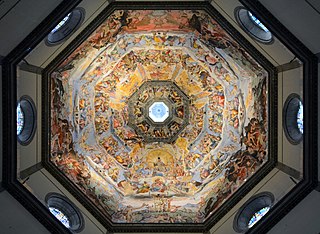
The Last Judgment in the Cattedrale di Santa Maria del Fiore, in Florence, Italy is a fresco painting which was begun by the Italian Renaissance master Giorgio Vasari in 1572 and completed after his death by Federico Zuccari, in 1579. Initially commissioned by Grand Duke Cosimo I de' Medici, it is located on the ceiling of the dome of the cathedral. It was the subject of an extensive restoration undertaken between 1989 and 1994.
References
- 1 2 "David Edward Hemsoll - Personal Appointments (free information from Companies House)". beta.companieshouse.gov.uk. Retrieved 11 September 2020.
- ↑ "Dr David Hemsoll - Department of Art History, Curating and Visual Studies - University of Birmingham". www.birmingham.ac.uk. Retrieved 11 September 2020.
- ↑ "Mr David Hemsoll". Society of Antiquaries of London. Retrieved 11 September 2020.
- ↑ "Research Fellowships 2017 | The Leverhulme Trust". www.leverhulme.ac.uk. Retrieved 11 September 2020.
- ↑ "Journal". SAHGB. Retrieved 11 September 2020.
- ↑ "David Hemsoll | I Tatti | The Harvard University Center for Italian Renaissance Studies". itatti.harvard.edu. Retrieved 11 September 2020.
- ↑ The Pantheon: From Antiquity to the Present. Cambridge University Press. p. 4. ISBN 978-0-521-80932-0.
- ↑ The Pantheon: From Antiquity to the Present. Cambridge University Press. p. 142. ISBN 978-0-521-80932-0.
- 1 2 3 Howard, Deborah (October 2020). "Renaissance Architecture - (D.) Hemsoll Emulating Antiquity. Renaissance Buildings from Brunelleschi to Michelangelo". The Classical Review. 70 (2): 511–513. doi:10.1017/S0009840X20000487. ISSN 0009-840X. S2CID 216272308.
- ↑ Hemsoll, David (3 April 2018). The Life of Michelangelo. Getty Publications. ISBN 978-1-60606-565-5.
- ↑ "ADH 2020: Shortlist Interview - David Hemsoll". SAHGB. 5 December 2020. Archived from the original on 6 December 2020. Retrieved 24 January 2021.
- ↑ "Who made the Conway Library?". Digital Media. 30 June 2020. Archived from the original on 3 July 2020. Retrieved 11 September 2020.